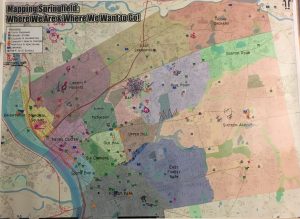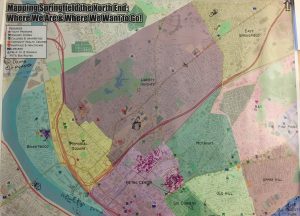As the pandemic began its sweep through the United States we have seen incredible mutual aid responses pop up all over the world, and in our local communities. And what better way to visualize those efforts than a map! The local Pioneer Valley mutual aid network reached out in need of a map to help […]
Category Archives: Updates
February 2020 Mystery Map
The mystery map returns! Take a look at the map below and explore the online interactive map to determine what the blue pins represent. Fill out this form to submit your guess! Add your submission by the end of February.
Spring 2020 Workshops
The Spatial Analysis Lab is excited to offer another set of workshops– new and old– for Spring 2020! Take a look at the schedule and mark your calendars for more spatial learning. Please give us a heads up by registering for the workshops that interest you. Snacks will be provided! Drone Ethics: Creating a […]
A semester in review: Fall 2019
What a semester! We’ve reached new heights this fall with new classes, workshops, and research. This semester we taught Drone Cinematography and Aerial Imagery, and assisted Contesting Space: Art, Ecology, Activism in Latin American & Latinx Studies, Great Cities: Los Angeles in Art History, and Researching Environmental Problems and Sustainable Solutions in Environmental Science & […]
Hannah’s Fall 2019 in Review
It’s been a busy SAL-mester here at the Spatial Analysis Lab! We’ve had a number of exciting projects this fall. Currently, I’m collaborating with an emeritus faculty member to help create a map for his book. Earlier in the semester, I tried my hand at mapping some donation data from the Hot Chocolate Run, though […]
Drone Technology & Climate Resiliency
Have you ever considered what a rock does all day? Where do they live and where do they go? In the past few months we’ve been assisting a team of sedimentary geoscientists studying these very questions– where do rocks move in the Mill River? We’ve been assisting their work by flying drone missions above their study […]
GIS Day at the SAL
Happy GIS Day! Here at the Spatial Analysis Lab celebrated with student films from our aerial cinematography class, hand drawn and printed maps, and of course, cake! We had a packed room for the mini film festival and learned about Hampshire College’s farm, automated milkers at Belden Dairy Farm, invasive plant species at Macleish Field […]
Smithies Around the World – lessons in geocoding
Are you a Smithie? Where in the world are you now? Well, that’s what the Smithies Around the World Map attempted to find out. In preparation for Reunion this past Spring, the SAL gathered data from the Office of Development to map the general locations of Smith alums’ current locations. Smith currently has information of […]
Community Mapping with Project SPARC
Project SPARC (Springfield Participatory Action Research Crew) and the Jandon Center invited the SAL to participate in their community event at Chestnut School in Springfield. We came to the event with two maps of Springfield that highlight various resources throughout the city– schools, universities, hospitals, community health centers, libraries, and youth programs– to help participants orient themselves and visualize their neighborhoods. I also came with the Highlander Center’s “Mapping Our Futures: Economics and Governance” curriculum to provide a foundation for the activity. They suggested to have questions posted to explore while working with their maps– I adapted them slightly for our purposes to say:
What do you see? On the map mark places:
- You like about your community
- You find helpful resources
- You like to gather and hang out
- That have power — institutions, groups, people
- You want to see change about your community
The event itself went great– there were many families that came and had fun at the various stations and enjoyed delicious food! I set up the maps on tables, laid out pre-measured yarn to create movable scales, and lots of different colored permanent markers. A steady flow of people moved throughout the activities and made their marks on the maps– we had lots of fun looking at the neighborhoods of Springfield, and usually someplace sparked a memory to share.
Some of the first people at the mapping station decided to add a heart to the legend to represent memories and a butterfly to represent dreams of change in specific places. People gravitated towards adding symbols on the map rather than annotating the maps. Most of the hearts were placed on schools. People also began to add proposals for change they wanted to see around Springfield. I think that by presenting maps with various resources already highlighted, it was easy for people to see what they didn’t have in their neighborhoods, and in turn, easy to identify and validate the need for more recreation centers, libraries, and other youth programs. Someone even proposed a zoo and a new mall for spaces to gather and hang out with friends. One person did annotate the maps by circling parks that they felt needed clean-up, even telling me that they had personally cleaned up the park once and emailed and called the city about getting a trash can. Someone wrote SOS next to a park, too.
Another person added a star to the map to represent therapeutic places, or places of mental health awareness. We had a conversation about places that encouraged healthy stress management and coping with mental health problems. They told me about how communities of color in Springfield don’t have easy access to places of relaxing and unwinding that would help with their mental health concerns. They like to manage their stress through exercise and going to the gym or going outside, but we also talked about how some people don’t feel safe when exercising outside and saw safe therapeutic spaces as a need for their community. This comment was echoed in some parents’ remembering their childhood experience in Springfield– they wanted to see more youth programs in their area specifically because they felt uncomfortable letting their kids go out to play unsupervised for very long.
All of these conversations generated lots of ideas about how to make Springfield better, what people love, what people want to see more of, and what people need. The act of mapping, I hope, creates a sense of worthiness and credibility– this comes from understanding maps as truth documents. The flip-side of this, of course, is finding the means to enact these proposals for change and can cause frustration if they don’t become a reality. I want to find better ways to have these conversations with people while being completely honest about where mapping stops and acting begins.
Two or three young people stayed at the mapping corner for almost the entire event. We located all the schools they attend and quickly the maps turned into a story– they took visioning and dreaming to a whole new level! One person created an entire story-line about someone escaping beavers and sharks in the Connecticut River and their trials and tribulations throughout their adventure in Springfield. We used the scale to figure out their character swam more than two miles up the river! Though these mappings weren’t “on topic” or working with the original intent of the activity, we still had great conversations about place and what it would be like to make the maps for books.
So what’s next? I want to work on helping steer young people with such vibrant imaginations into the activity better. Right now the way I have this workshop set-up is geared more towards older kids and adults. I noticed that I wasn’t able to explain the activity quick enough to help people get the most out of the maps. Since it was an open drop-in event, I let people interpret as they see fit and kept the guidelines as loose as possible, however, that may have been more confusing to some. I need to create more succinct directions without locking participants into only one way of seeing and using the maps. Having the written questions on a poster didn’t seem to help– perhaps they were often hidden by the maps themselves, but most people didn’t know what to do even when reading the guiding questions I prepared. Some also noted that they couldn’t see the details of the maps well– perhaps I will bring a magnifying glasses or reading classes next time! Lots of ways to improve for the next workshop. If you have any ideas, please contact Emma Harnisch (eharnisch@smith.edu).
Summer at the SAL by Hannah Davis
It’s almost the middle of summer and things are heating up at the Smith Spatial Analysis Lab. This summer has seen the continuation of many exciting projects, and the start of a number more. As the Spatial Analysis Lab intern, I had the privilege of working with a wide variety of people across campus. I […]



